Community Based Education: A Comprehensive Guide
VerifiedAdded on 2023/04/25
|10
|2226
|204
AI Summary
This article provides a comprehensive guide to Community Based Education (CBE) and its importance in medical education. It covers the history and evolution of CBE, its social accountability, and the rationale behind its adoption in institutes. The article also discusses the benefits of CBE and how it helps students build a sense of association with their communities. The document type is an essay, and the type of assignment is an informative article. The subject is medical education, and the course code, course name, and college/university are not mentioned.
Contribute Materials
Your contribution can guide someone’s learning journey. Share your
documents today.
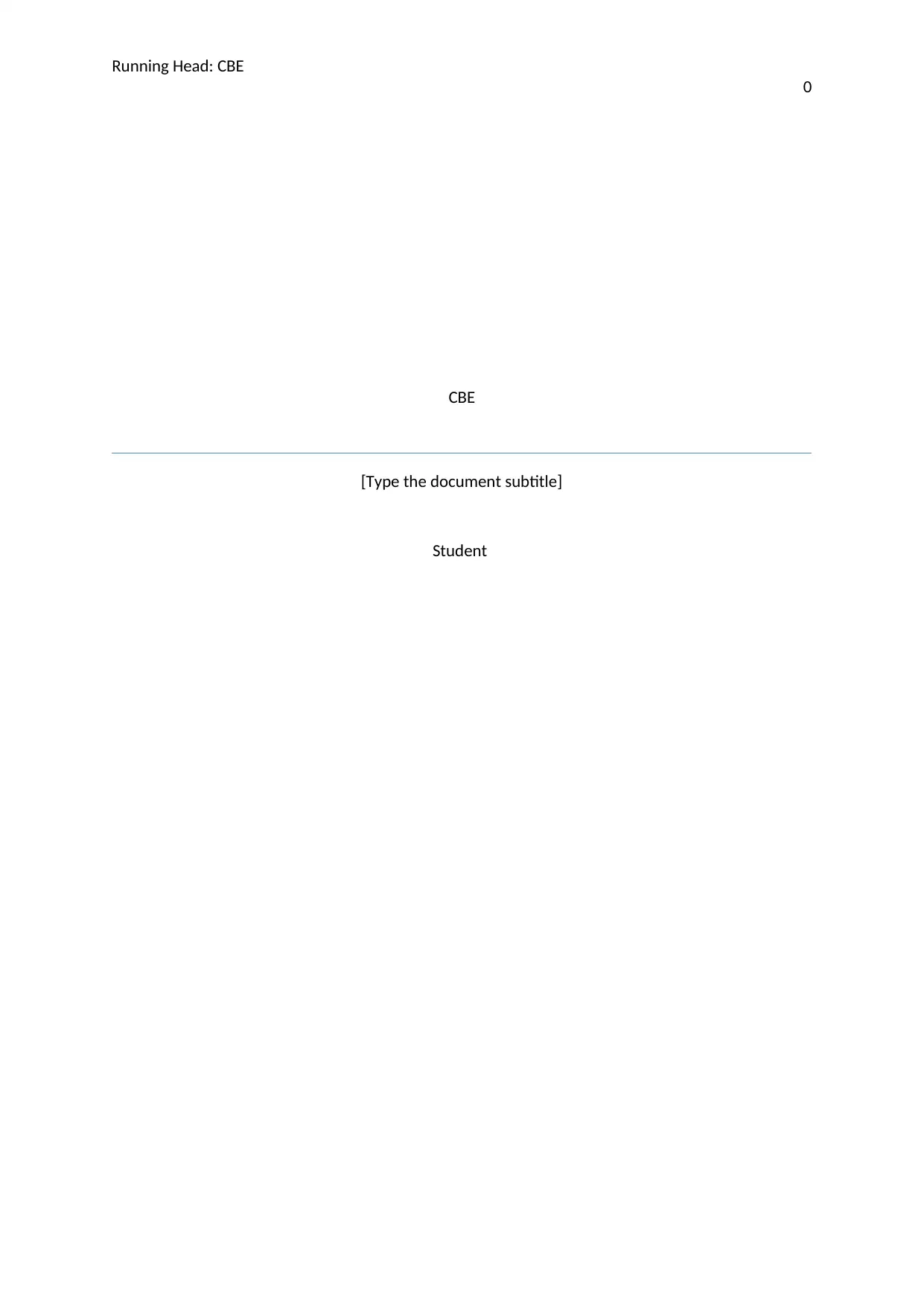
Running Head: CBE
0
CBE
[Type the document subtitle]
Student
0
CBE
[Type the document subtitle]
Student
Secure Best Marks with AI Grader
Need help grading? Try our AI Grader for instant feedback on your assignments.
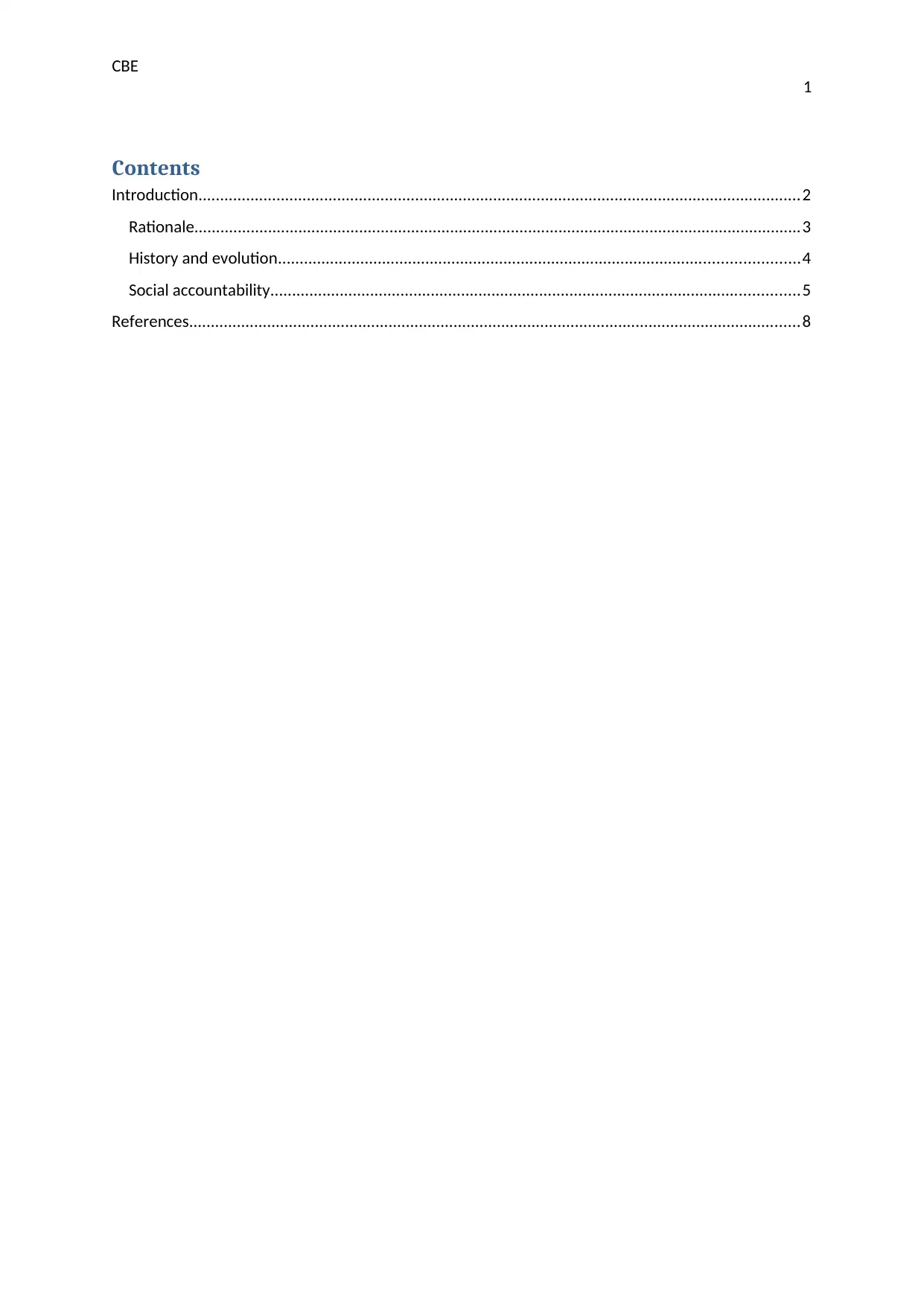
CBE
1
Contents
Introduction...........................................................................................................................................2
Rationale............................................................................................................................................3
History and evolution........................................................................................................................4
Social accountability..........................................................................................................................5
References.............................................................................................................................................8
1
Contents
Introduction...........................................................................................................................................2
Rationale............................................................................................................................................3
History and evolution........................................................................................................................4
Social accountability..........................................................................................................................5
References.............................................................................................................................................8
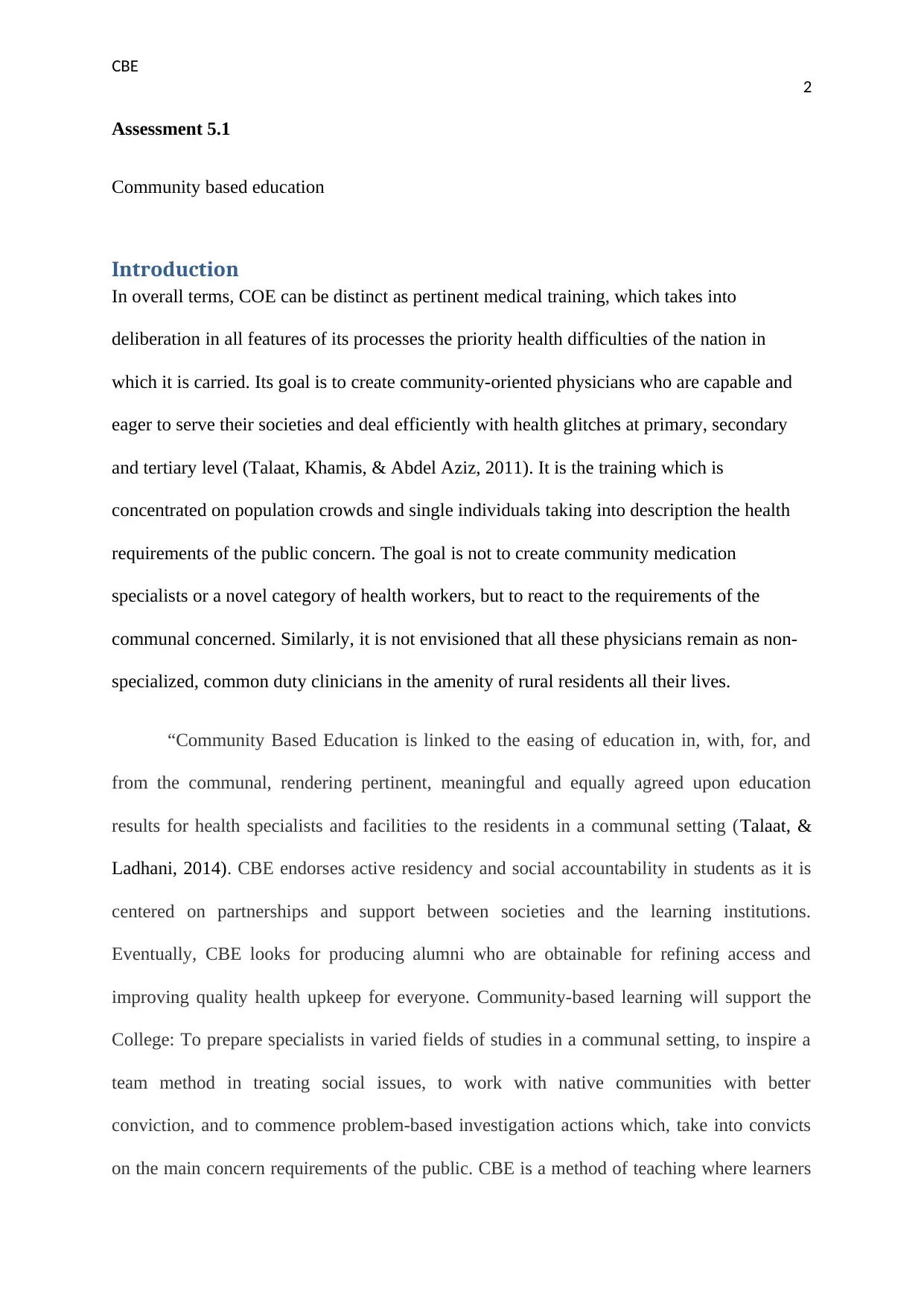
CBE
2
Assessment 5.1
Community based education
Introduction
In overall terms, COE can be distinct as pertinent medical training, which takes into
deliberation in all features of its processes the priority health difficulties of the nation in
which it is carried. Its goal is to create community-oriented physicians who are capable and
eager to serve their societies and deal efficiently with health glitches at primary, secondary
and tertiary level (Talaat, Khamis, & Abdel Aziz, 2011). It is the training which is
concentrated on population crowds and single individuals taking into description the health
requirements of the public concern. The goal is not to create community medication
specialists or a novel category of health workers, but to react to the requirements of the
communal concerned. Similarly, it is not envisioned that all these physicians remain as non-
specialized, common duty clinicians in the amenity of rural residents all their lives.
“Community Based Education is linked to the easing of education in, with, for, and
from the communal, rendering pertinent, meaningful and equally agreed upon education
results for health specialists and facilities to the residents in a communal setting (Talaat, &
Ladhani, 2014). CBE endorses active residency and social accountability in students as it is
centered on partnerships and support between societies and the learning institutions.
Eventually, CBE looks for producing alumni who are obtainable for refining access and
improving quality health upkeep for everyone. Community-based learning will support the
College: To prepare specialists in varied fields of studies in a communal setting, to inspire a
team method in treating social issues, to work with native communities with better
conviction, and to commence problem-based investigation actions which, take into convicts
on the main concern requirements of the public. CBE is a method of teaching where learners
2
Assessment 5.1
Community based education
Introduction
In overall terms, COE can be distinct as pertinent medical training, which takes into
deliberation in all features of its processes the priority health difficulties of the nation in
which it is carried. Its goal is to create community-oriented physicians who are capable and
eager to serve their societies and deal efficiently with health glitches at primary, secondary
and tertiary level (Talaat, Khamis, & Abdel Aziz, 2011). It is the training which is
concentrated on population crowds and single individuals taking into description the health
requirements of the public concern. The goal is not to create community medication
specialists or a novel category of health workers, but to react to the requirements of the
communal concerned. Similarly, it is not envisioned that all these physicians remain as non-
specialized, common duty clinicians in the amenity of rural residents all their lives.
“Community Based Education is linked to the easing of education in, with, for, and
from the communal, rendering pertinent, meaningful and equally agreed upon education
results for health specialists and facilities to the residents in a communal setting (Talaat, &
Ladhani, 2014). CBE endorses active residency and social accountability in students as it is
centered on partnerships and support between societies and the learning institutions.
Eventually, CBE looks for producing alumni who are obtainable for refining access and
improving quality health upkeep for everyone. Community-based learning will support the
College: To prepare specialists in varied fields of studies in a communal setting, to inspire a
team method in treating social issues, to work with native communities with better
conviction, and to commence problem-based investigation actions which, take into convicts
on the main concern requirements of the public. CBE is a method of teaching where learners
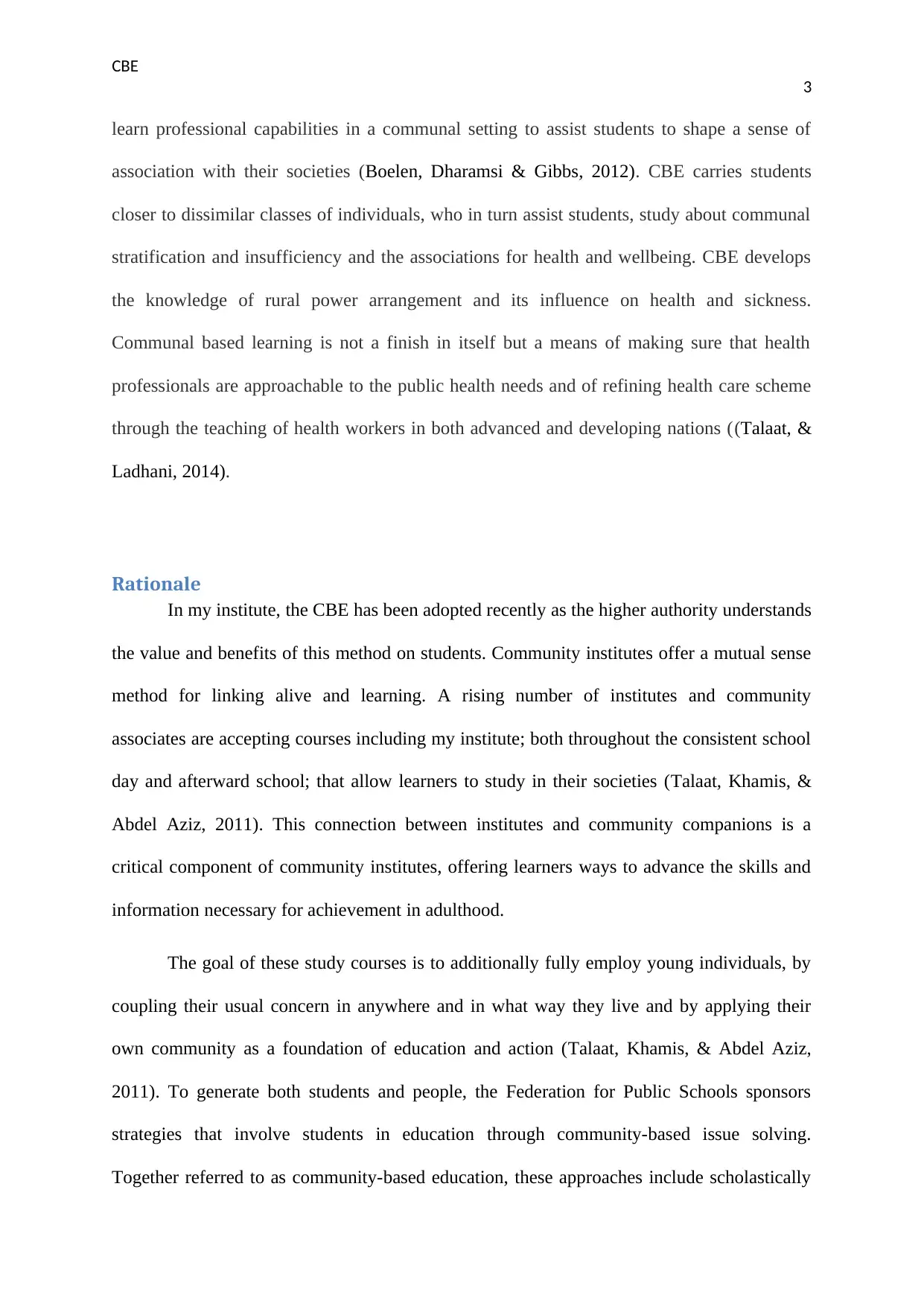
CBE
3
learn professional capabilities in a communal setting to assist students to shape a sense of
association with their societies (Boelen, Dharamsi & Gibbs, 2012). CBE carries students
closer to dissimilar classes of individuals, who in turn assist students, study about communal
stratification and insufficiency and the associations for health and wellbeing. CBE develops
the knowledge of rural power arrangement and its influence on health and sickness.
Communal based learning is not a finish in itself but a means of making sure that health
professionals are approachable to the public health needs and of refining health care scheme
through the teaching of health workers in both advanced and developing nations ((Talaat, &
Ladhani, 2014).
Rationale
In my institute, the CBE has been adopted recently as the higher authority understands
the value and benefits of this method on students. Community institutes offer a mutual sense
method for linking alive and learning. A rising number of institutes and community
associates are accepting courses including my institute; both throughout the consistent school
day and afterward school; that allow learners to study in their societies (Talaat, Khamis, &
Abdel Aziz, 2011). This connection between institutes and community companions is a
critical component of community institutes, offering learners ways to advance the skills and
information necessary for achievement in adulthood.
The goal of these study courses is to additionally fully employ young individuals, by
coupling their usual concern in anywhere and in what way they live and by applying their
own community as a foundation of education and action (Talaat, Khamis, & Abdel Aziz,
2011). To generate both students and people, the Federation for Public Schools sponsors
strategies that involve students in education through community-based issue solving.
Together referred to as community-based education, these approaches include scholastically
3
learn professional capabilities in a communal setting to assist students to shape a sense of
association with their societies (Boelen, Dharamsi & Gibbs, 2012). CBE carries students
closer to dissimilar classes of individuals, who in turn assist students, study about communal
stratification and insufficiency and the associations for health and wellbeing. CBE develops
the knowledge of rural power arrangement and its influence on health and sickness.
Communal based learning is not a finish in itself but a means of making sure that health
professionals are approachable to the public health needs and of refining health care scheme
through the teaching of health workers in both advanced and developing nations ((Talaat, &
Ladhani, 2014).
Rationale
In my institute, the CBE has been adopted recently as the higher authority understands
the value and benefits of this method on students. Community institutes offer a mutual sense
method for linking alive and learning. A rising number of institutes and community
associates are accepting courses including my institute; both throughout the consistent school
day and afterward school; that allow learners to study in their societies (Talaat, Khamis, &
Abdel Aziz, 2011). This connection between institutes and community companions is a
critical component of community institutes, offering learners ways to advance the skills and
information necessary for achievement in adulthood.
The goal of these study courses is to additionally fully employ young individuals, by
coupling their usual concern in anywhere and in what way they live and by applying their
own community as a foundation of education and action (Talaat, Khamis, & Abdel Aziz,
2011). To generate both students and people, the Federation for Public Schools sponsors
strategies that involve students in education through community-based issue solving.
Together referred to as community-based education, these approaches include scholastically
Secure Best Marks with AI Grader
Need help grading? Try our AI Grader for instant feedback on your assignments.
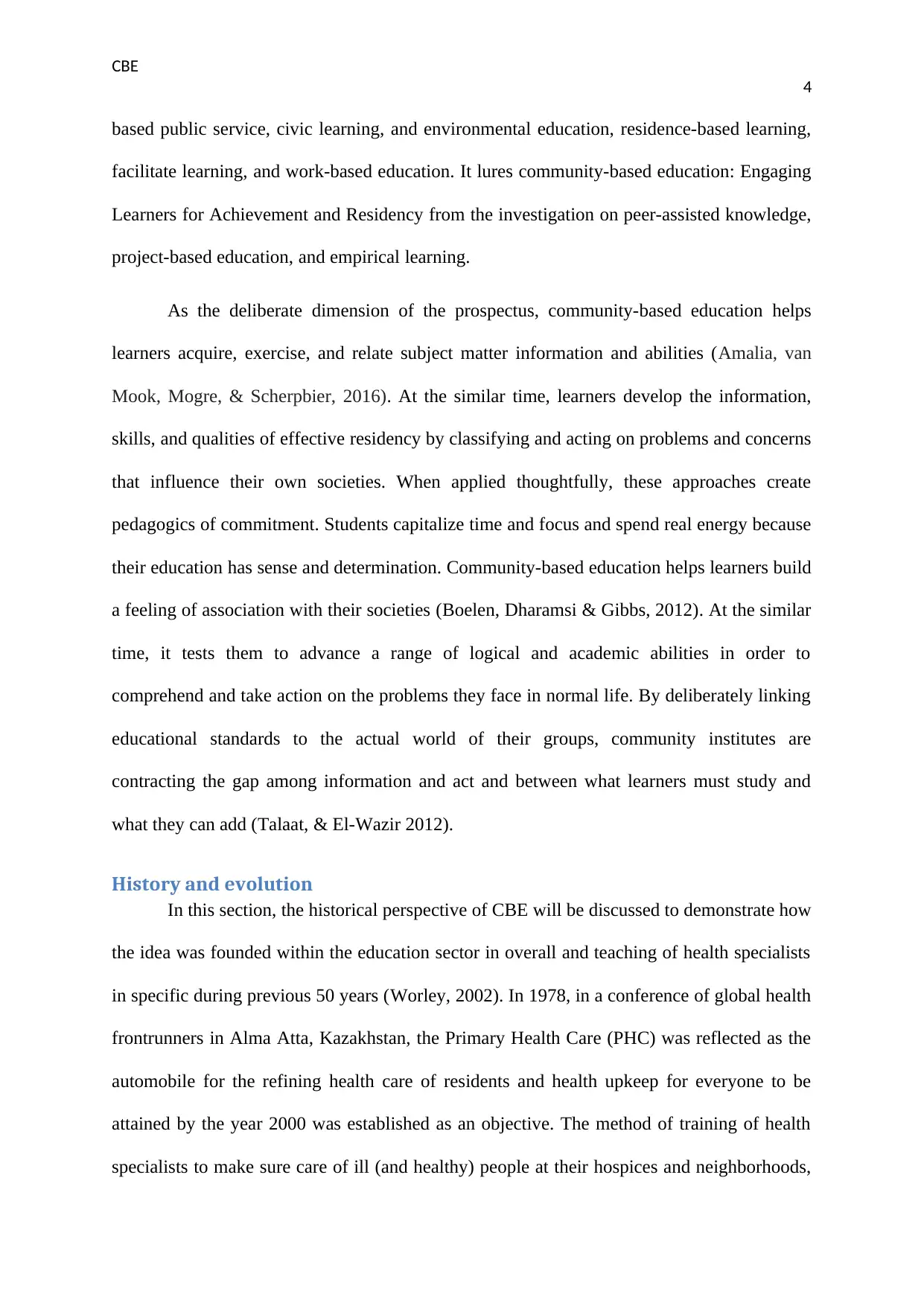
CBE
4
based public service, civic learning, and environmental education, residence-based learning,
facilitate learning, and work-based education. It lures community-based education: Engaging
Learners for Achievement and Residency from the investigation on peer-assisted knowledge,
project-based education, and empirical learning.
As the deliberate dimension of the prospectus, community-based education helps
learners acquire, exercise, and relate subject matter information and abilities (Amalia, van
Mook, Mogre, & Scherpbier, 2016). At the similar time, learners develop the information,
skills, and qualities of effective residency by classifying and acting on problems and concerns
that influence their own societies. When applied thoughtfully, these approaches create
pedagogics of commitment. Students capitalize time and focus and spend real energy because
their education has sense and determination. Community-based education helps learners build
a feeling of association with their societies (Boelen, Dharamsi & Gibbs, 2012). At the similar
time, it tests them to advance a range of logical and academic abilities in order to
comprehend and take action on the problems they face in normal life. By deliberately linking
educational standards to the actual world of their groups, community institutes are
contracting the gap among information and act and between what learners must study and
what they can add (Talaat, & El-Wazir 2012).
History and evolution
In this section, the historical perspective of CBE will be discussed to demonstrate how
the idea was founded within the education sector in overall and teaching of health specialists
in specific during previous 50 years (Worley, 2002). In 1978, in a conference of global health
frontrunners in Alma Atta, Kazakhstan, the Primary Health Care (PHC) was reflected as the
automobile for the refining health care of residents and health upkeep for everyone to be
attained by the year 2000 was established as an objective. The method of training of health
specialists to make sure care of ill (and healthy) people at their hospices and neighborhoods,
4
based public service, civic learning, and environmental education, residence-based learning,
facilitate learning, and work-based education. It lures community-based education: Engaging
Learners for Achievement and Residency from the investigation on peer-assisted knowledge,
project-based education, and empirical learning.
As the deliberate dimension of the prospectus, community-based education helps
learners acquire, exercise, and relate subject matter information and abilities (Amalia, van
Mook, Mogre, & Scherpbier, 2016). At the similar time, learners develop the information,
skills, and qualities of effective residency by classifying and acting on problems and concerns
that influence their own societies. When applied thoughtfully, these approaches create
pedagogics of commitment. Students capitalize time and focus and spend real energy because
their education has sense and determination. Community-based education helps learners build
a feeling of association with their societies (Boelen, Dharamsi & Gibbs, 2012). At the similar
time, it tests them to advance a range of logical and academic abilities in order to
comprehend and take action on the problems they face in normal life. By deliberately linking
educational standards to the actual world of their groups, community institutes are
contracting the gap among information and act and between what learners must study and
what they can add (Talaat, & El-Wazir 2012).
History and evolution
In this section, the historical perspective of CBE will be discussed to demonstrate how
the idea was founded within the education sector in overall and teaching of health specialists
in specific during previous 50 years (Worley, 2002). In 1978, in a conference of global health
frontrunners in Alma Atta, Kazakhstan, the Primary Health Care (PHC) was reflected as the
automobile for the refining health care of residents and health upkeep for everyone to be
attained by the year 2000 was established as an objective. The method of training of health
specialists to make sure care of ill (and healthy) people at their hospices and neighborhoods,
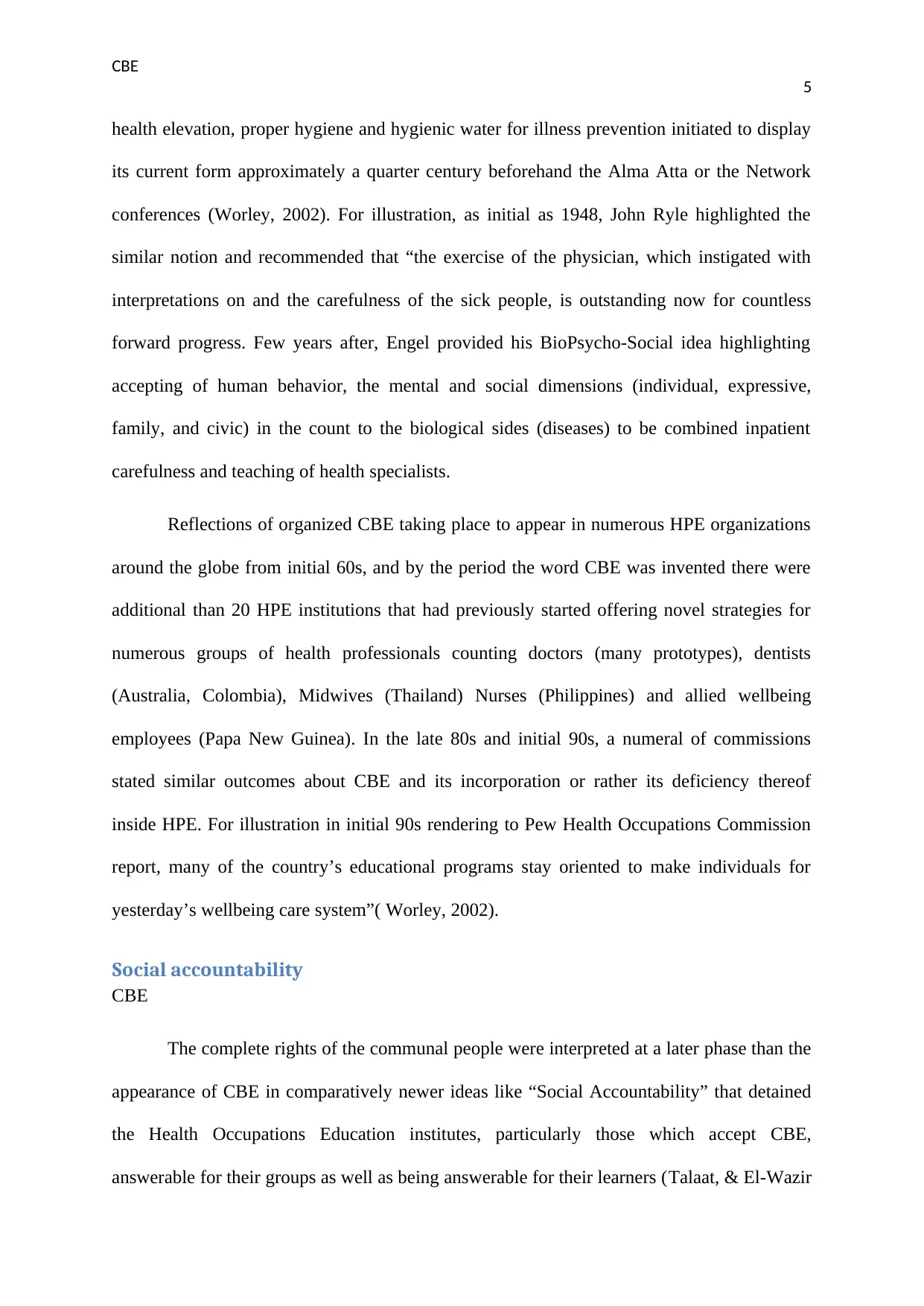
CBE
5
health elevation, proper hygiene and hygienic water for illness prevention initiated to display
its current form approximately a quarter century beforehand the Alma Atta or the Network
conferences (Worley, 2002). For illustration, as initial as 1948, John Ryle highlighted the
similar notion and recommended that “the exercise of the physician, which instigated with
interpretations on and the carefulness of the sick people, is outstanding now for countless
forward progress. Few years after, Engel provided his BioPsycho-Social idea highlighting
accepting of human behavior, the mental and social dimensions (individual, expressive,
family, and civic) in the count to the biological sides (diseases) to be combined inpatient
carefulness and teaching of health specialists.
Reflections of organized CBE taking place to appear in numerous HPE organizations
around the globe from initial 60s, and by the period the word CBE was invented there were
additional than 20 HPE institutions that had previously started offering novel strategies for
numerous groups of health professionals counting doctors (many prototypes), dentists
(Australia, Colombia), Midwives (Thailand) Nurses (Philippines) and allied wellbeing
employees (Papa New Guinea). In the late 80s and initial 90s, a numeral of commissions
stated similar outcomes about CBE and its incorporation or rather its deficiency thereof
inside HPE. For illustration in initial 90s rendering to Pew Health Occupations Commission
report, many of the country’s educational programs stay oriented to make individuals for
yesterday’s wellbeing care system”( Worley, 2002).
Social accountability
CBE
The complete rights of the communal people were interpreted at a later phase than the
appearance of CBE in comparatively newer ideas like “Social Accountability” that detained
the Health Occupations Education institutes, particularly those which accept CBE,
answerable for their groups as well as being answerable for their learners (Talaat, & El-Wazir
5
health elevation, proper hygiene and hygienic water for illness prevention initiated to display
its current form approximately a quarter century beforehand the Alma Atta or the Network
conferences (Worley, 2002). For illustration, as initial as 1948, John Ryle highlighted the
similar notion and recommended that “the exercise of the physician, which instigated with
interpretations on and the carefulness of the sick people, is outstanding now for countless
forward progress. Few years after, Engel provided his BioPsycho-Social idea highlighting
accepting of human behavior, the mental and social dimensions (individual, expressive,
family, and civic) in the count to the biological sides (diseases) to be combined inpatient
carefulness and teaching of health specialists.
Reflections of organized CBE taking place to appear in numerous HPE organizations
around the globe from initial 60s, and by the period the word CBE was invented there were
additional than 20 HPE institutions that had previously started offering novel strategies for
numerous groups of health professionals counting doctors (many prototypes), dentists
(Australia, Colombia), Midwives (Thailand) Nurses (Philippines) and allied wellbeing
employees (Papa New Guinea). In the late 80s and initial 90s, a numeral of commissions
stated similar outcomes about CBE and its incorporation or rather its deficiency thereof
inside HPE. For illustration in initial 90s rendering to Pew Health Occupations Commission
report, many of the country’s educational programs stay oriented to make individuals for
yesterday’s wellbeing care system”( Worley, 2002).
Social accountability
CBE
The complete rights of the communal people were interpreted at a later phase than the
appearance of CBE in comparatively newer ideas like “Social Accountability” that detained
the Health Occupations Education institutes, particularly those which accept CBE,
answerable for their groups as well as being answerable for their learners (Talaat, & El-Wazir
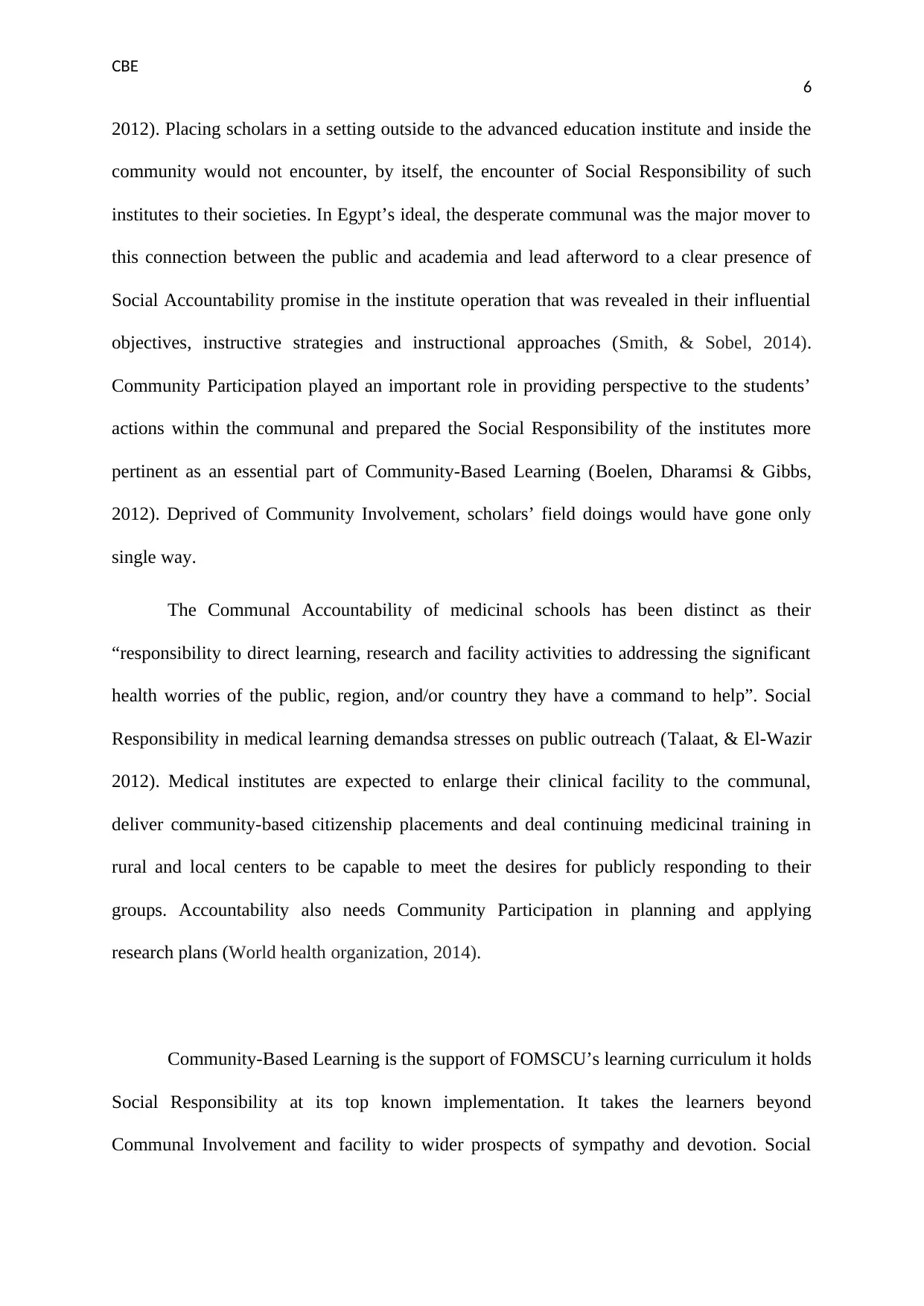
CBE
6
2012). Placing scholars in a setting outside to the advanced education institute and inside the
community would not encounter, by itself, the encounter of Social Responsibility of such
institutes to their societies. In Egypt’s ideal, the desperate communal was the major mover to
this connection between the public and academia and lead afterword to a clear presence of
Social Accountability promise in the institute operation that was revealed in their influential
objectives, instructive strategies and instructional approaches (Smith, & Sobel, 2014).
Community Participation played an important role in providing perspective to the students’
actions within the communal and prepared the Social Responsibility of the institutes more
pertinent as an essential part of Community-Based Learning (Boelen, Dharamsi & Gibbs,
2012). Deprived of Community Involvement, scholars’ field doings would have gone only
single way.
The Communal Accountability of medicinal schools has been distinct as their
“responsibility to direct learning, research and facility activities to addressing the significant
health worries of the public, region, and/or country they have a command to help”. Social
Responsibility in medical learning demandsa stresses on public outreach (Talaat, & El-Wazir
2012). Medical institutes are expected to enlarge their clinical facility to the communal,
deliver community-based citizenship placements and deal continuing medicinal training in
rural and local centers to be capable to meet the desires for publicly responding to their
groups. Accountability also needs Community Participation in planning and applying
research plans (World health organization, 2014).
Community-Based Learning is the support of FOMSCU’s learning curriculum it holds
Social Responsibility at its top known implementation. It takes the learners beyond
Communal Involvement and facility to wider prospects of sympathy and devotion. Social
6
2012). Placing scholars in a setting outside to the advanced education institute and inside the
community would not encounter, by itself, the encounter of Social Responsibility of such
institutes to their societies. In Egypt’s ideal, the desperate communal was the major mover to
this connection between the public and academia and lead afterword to a clear presence of
Social Accountability promise in the institute operation that was revealed in their influential
objectives, instructive strategies and instructional approaches (Smith, & Sobel, 2014).
Community Participation played an important role in providing perspective to the students’
actions within the communal and prepared the Social Responsibility of the institutes more
pertinent as an essential part of Community-Based Learning (Boelen, Dharamsi & Gibbs,
2012). Deprived of Community Involvement, scholars’ field doings would have gone only
single way.
The Communal Accountability of medicinal schools has been distinct as their
“responsibility to direct learning, research and facility activities to addressing the significant
health worries of the public, region, and/or country they have a command to help”. Social
Responsibility in medical learning demandsa stresses on public outreach (Talaat, & El-Wazir
2012). Medical institutes are expected to enlarge their clinical facility to the communal,
deliver community-based citizenship placements and deal continuing medicinal training in
rural and local centers to be capable to meet the desires for publicly responding to their
groups. Accountability also needs Community Participation in planning and applying
research plans (World health organization, 2014).
Community-Based Learning is the support of FOMSCU’s learning curriculum it holds
Social Responsibility at its top known implementation. It takes the learners beyond
Communal Involvement and facility to wider prospects of sympathy and devotion. Social
Paraphrase This Document
Need a fresh take? Get an instant paraphrase of this document with our AI Paraphraser
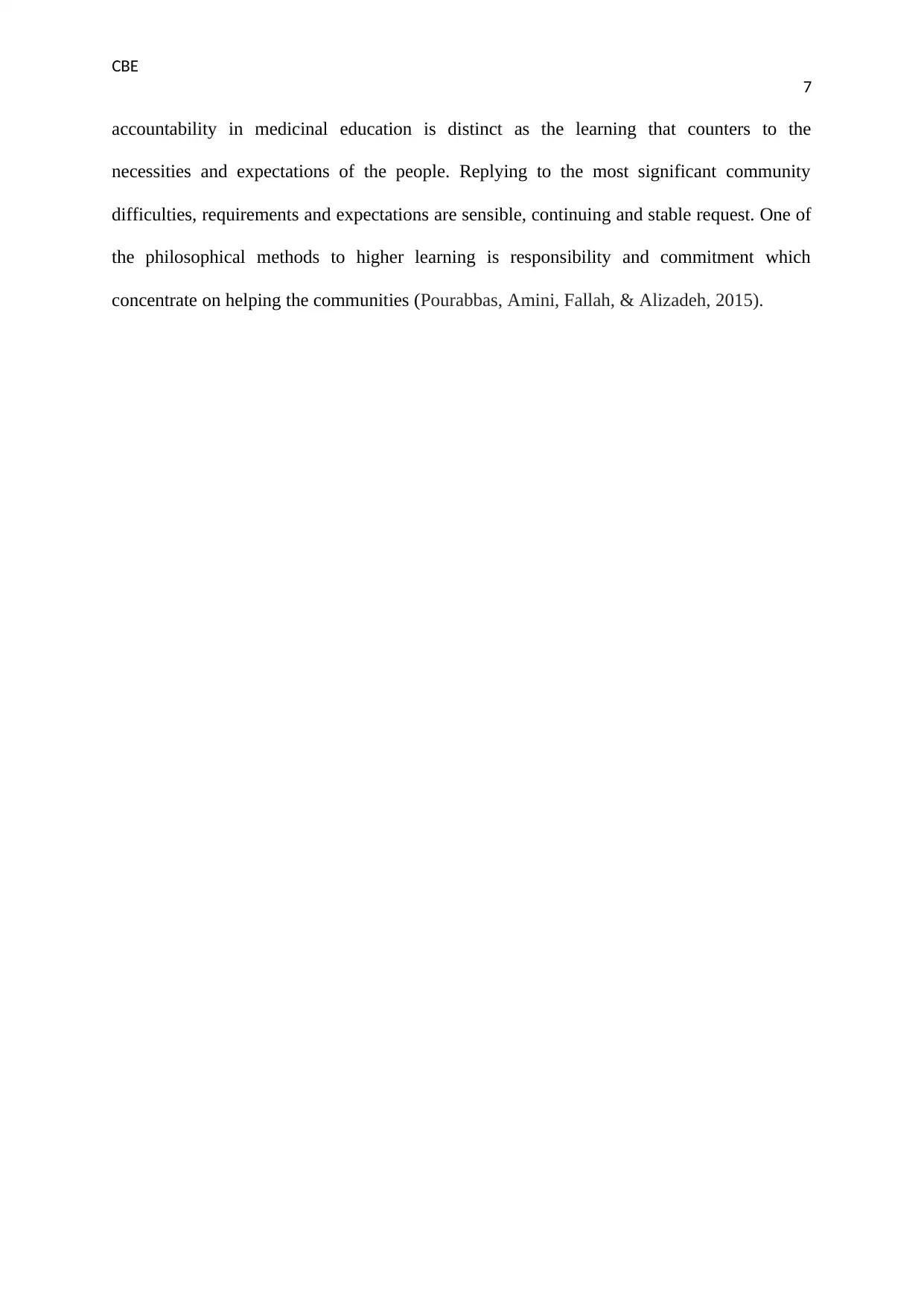
CBE
7
accountability in medicinal education is distinct as the learning that counters to the
necessities and expectations of the people. Replying to the most significant community
difficulties, requirements and expectations are sensible, continuing and stable request. One of
the philosophical methods to higher learning is responsibility and commitment which
concentrate on helping the communities (Pourabbas, Amini, Fallah, & Alizadeh, 2015).
7
accountability in medicinal education is distinct as the learning that counters to the
necessities and expectations of the people. Replying to the most significant community
difficulties, requirements and expectations are sensible, continuing and stable request. One of
the philosophical methods to higher learning is responsibility and commitment which
concentrate on helping the communities (Pourabbas, Amini, Fallah, & Alizadeh, 2015).
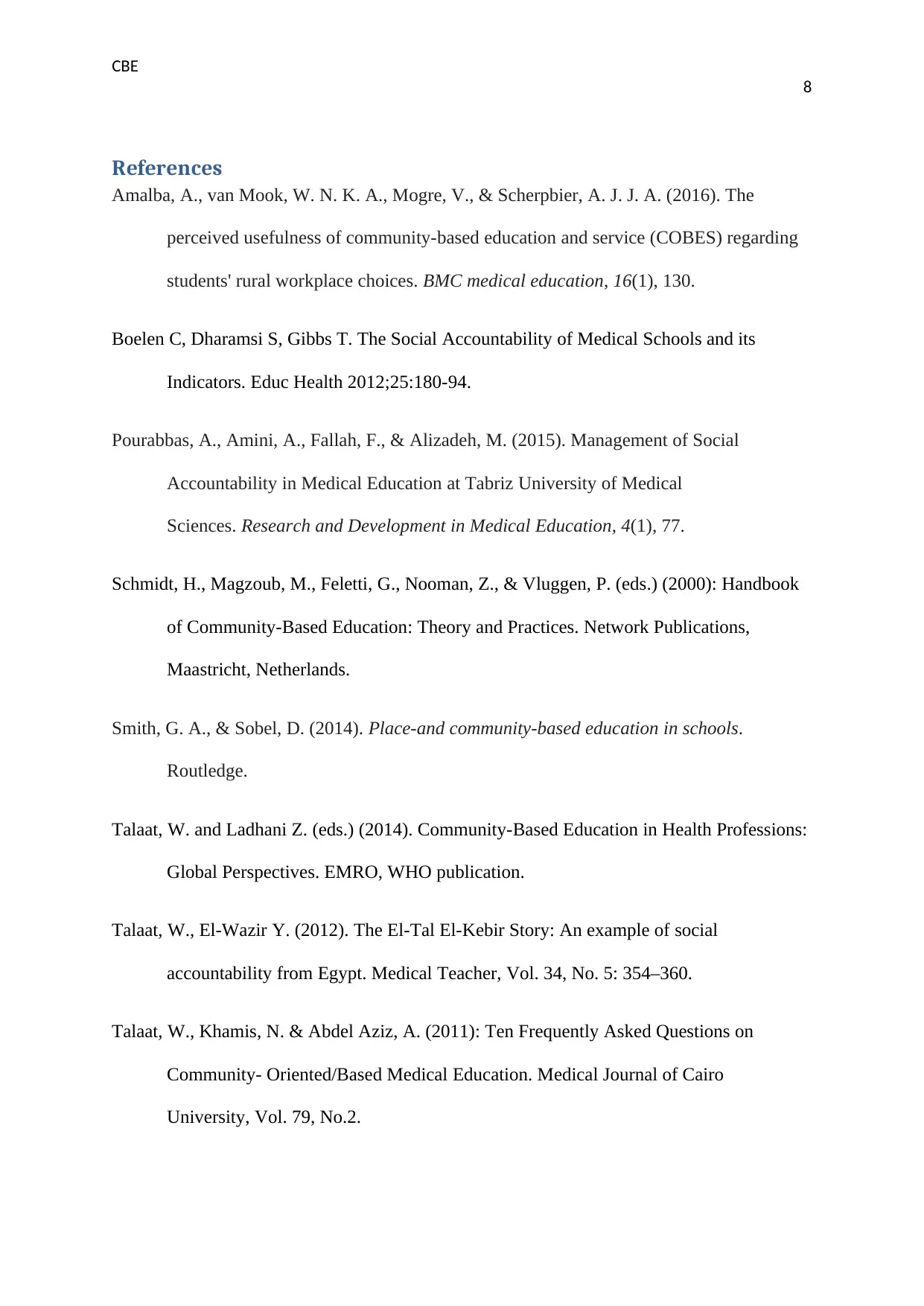
CBE
8
References
Amalba, A., van Mook, W. N. K. A., Mogre, V., & Scherpbier, A. J. J. A. (2016). The
perceived usefulness of community-based education and service (COBES) regarding
students' rural workplace choices. BMC medical education, 16(1), 130.
Boelen C, Dharamsi S, Gibbs T. The Social Accountability of Medical Schools and its
Indicators. Educ Health 2012;25:180-94.
Pourabbas, A., Amini, A., Fallah, F., & Alizadeh, M. (2015). Management of Social
Accountability in Medical Education at Tabriz University of Medical
Sciences. Research and Development in Medical Education, 4(1), 77.
Schmidt, H., Magzoub, M., Feletti, G., Nooman, Z., & Vluggen, P. (eds.) (2000): Handbook
of Community-Based Education: Theory and Practices. Network Publications,
Maastricht, Netherlands.
Smith, G. A., & Sobel, D. (2014). Place-and community-based education in schools.
Routledge.
Talaat, W. and Ladhani Z. (eds.) (2014). Community-Based Education in Health Professions:
Global Perspectives. EMRO, WHO publication.
Talaat, W., El-Wazir Y. (2012). The El-Tal El-Kebir Story: An example of social
accountability from Egypt. Medical Teacher, Vol. 34, No. 5: 354–360.
Talaat, W., Khamis, N. & Abdel Aziz, A. (2011): Ten Frequently Asked Questions on
Community- Oriented/Based Medical Education. Medical Journal of Cairo
University, Vol. 79, No.2.
8
References
Amalba, A., van Mook, W. N. K. A., Mogre, V., & Scherpbier, A. J. J. A. (2016). The
perceived usefulness of community-based education and service (COBES) regarding
students' rural workplace choices. BMC medical education, 16(1), 130.
Boelen C, Dharamsi S, Gibbs T. The Social Accountability of Medical Schools and its
Indicators. Educ Health 2012;25:180-94.
Pourabbas, A., Amini, A., Fallah, F., & Alizadeh, M. (2015). Management of Social
Accountability in Medical Education at Tabriz University of Medical
Sciences. Research and Development in Medical Education, 4(1), 77.
Schmidt, H., Magzoub, M., Feletti, G., Nooman, Z., & Vluggen, P. (eds.) (2000): Handbook
of Community-Based Education: Theory and Practices. Network Publications,
Maastricht, Netherlands.
Smith, G. A., & Sobel, D. (2014). Place-and community-based education in schools.
Routledge.
Talaat, W. and Ladhani Z. (eds.) (2014). Community-Based Education in Health Professions:
Global Perspectives. EMRO, WHO publication.
Talaat, W., El-Wazir Y. (2012). The El-Tal El-Kebir Story: An example of social
accountability from Egypt. Medical Teacher, Vol. 34, No. 5: 354–360.
Talaat, W., Khamis, N. & Abdel Aziz, A. (2011): Ten Frequently Asked Questions on
Community- Oriented/Based Medical Education. Medical Journal of Cairo
University, Vol. 79, No.2.
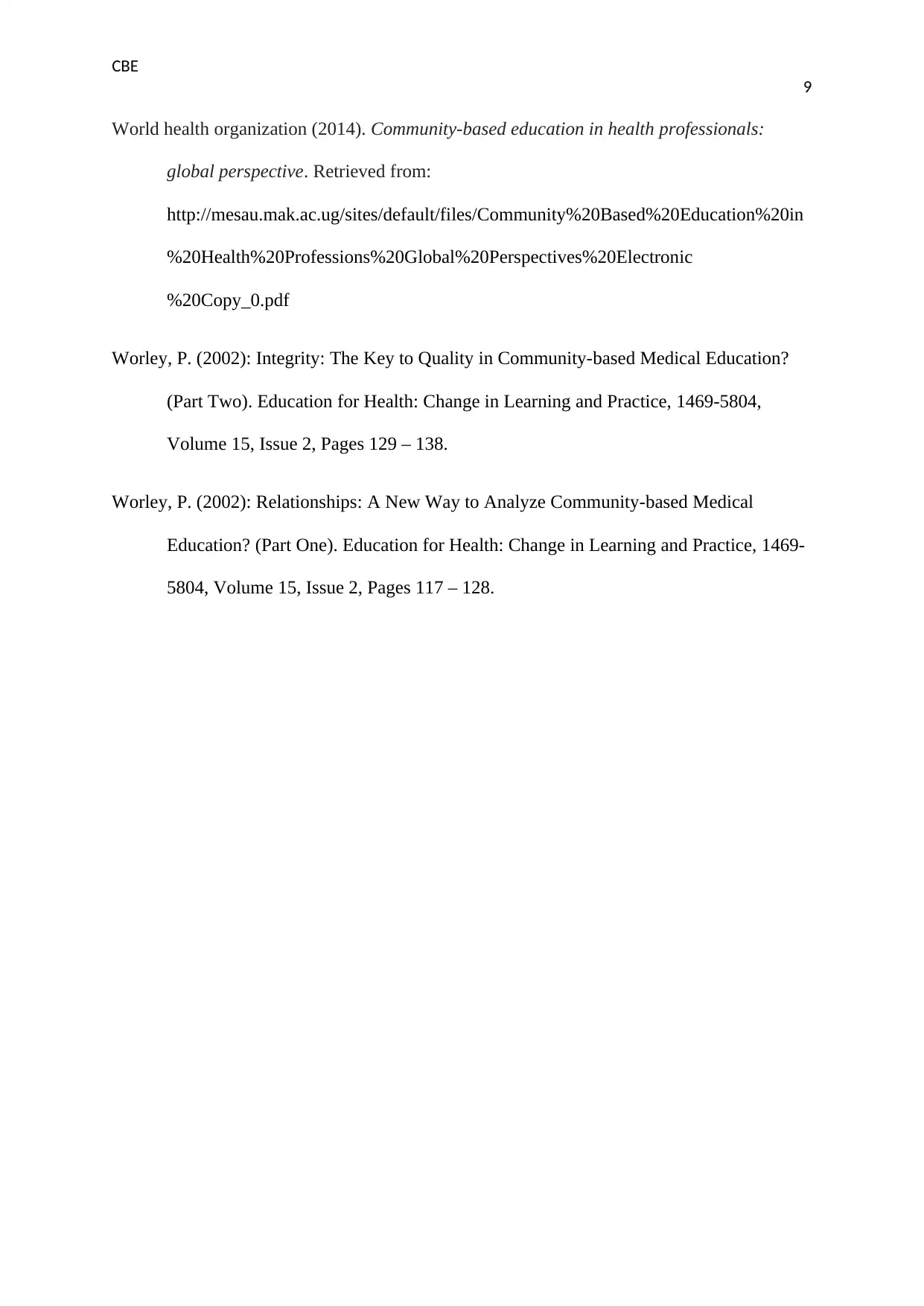
CBE
9
World health organization (2014). Community-based education in health professionals:
global perspective. Retrieved from:
http://mesau.mak.ac.ug/sites/default/files/Community%20Based%20Education%20in
%20Health%20Professions%20Global%20Perspectives%20Electronic
%20Copy_0.pdf
Worley, P. (2002): Integrity: The Key to Quality in Community-based Medical Education?
(Part Two). Education for Health: Change in Learning and Practice, 1469-5804,
Volume 15, Issue 2, Pages 129 – 138.
Worley, P. (2002): Relationships: A New Way to Analyze Community-based Medical
Education? (Part One). Education for Health: Change in Learning and Practice, 1469-
5804, Volume 15, Issue 2, Pages 117 – 128.
9
World health organization (2014). Community-based education in health professionals:
global perspective. Retrieved from:
http://mesau.mak.ac.ug/sites/default/files/Community%20Based%20Education%20in
%20Health%20Professions%20Global%20Perspectives%20Electronic
%20Copy_0.pdf
Worley, P. (2002): Integrity: The Key to Quality in Community-based Medical Education?
(Part Two). Education for Health: Change in Learning and Practice, 1469-5804,
Volume 15, Issue 2, Pages 129 – 138.
Worley, P. (2002): Relationships: A New Way to Analyze Community-based Medical
Education? (Part One). Education for Health: Change in Learning and Practice, 1469-
5804, Volume 15, Issue 2, Pages 117 – 128.
1 out of 10
Your All-in-One AI-Powered Toolkit for Academic Success.
+13062052269
info@desklib.com
Available 24*7 on WhatsApp / Email
![[object Object]](/_next/static/media/star-bottom.7253800d.svg)
Unlock your academic potential
© 2024 | Zucol Services PVT LTD | All rights reserved.


